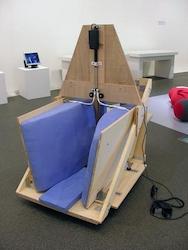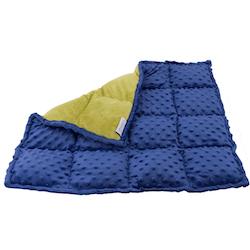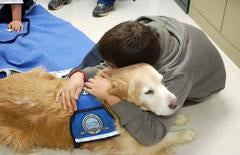Your Cart is Empty
Save up to 20% on all Harkla products & courses during Autism Acceptance Month! Click Here to See the Sale

With a rise in popularity over the past couple of years, people are wondering why weighted blankets are so calming.
The reason is deep touch pressure!
But, before we dive into what deep touch pressure (DTP) is, it's important to start with our body's sensory system to figure out why DTP is even an important and useful therapy to consider.
Sensory Integration is the process your central nervous system goes through when it takes information in from the environment and your body’s eight senses, processes that information, and then responds accordingly.
Your body takes information in through 8 sensory systems:

When one’s central nervous system has difficulty processing any of this sensory information, the body’s responses are atypical and can be observed in motor, language, or social-emotional difficulties.
Deep pressure or deep touch pressure therapy (DTP) is firm tactile sensory input that provides proprioceptive input to the whole body. This can consist of firm hugs, firm strokings, cuddling, hugging, squeezing, compression, or swaddling. When administered to the whole body, deep touch pressure therapy (DTP) has a calming, organizing effect on children and adults alike.
When considering your body’s physiological responses to sensory information, and your own emotional reactions, you need to consider the 3 different parts of your Autonomic Nervous System (ANS) and how those systems work together to help you function.
The autonomic nervous system is responsible for receiving information from your body and environment and sending signals out to regulate the functions of many of your body’s organs in response to that information. Think about the last time you were nervous - sweaty palms, racing heartbeat, fast breathing, and maybe even an upset stomach.
On the other hand, think about how you relax every night as you drift off to sleep - slow, deep breathing, slow heartbeat, relaxed muscles. All of those physiological responses came from your functioning autonomic nervous system (ANS).
The ANS is comprised of the parasympathetic, sympathetic, and enteric (gut) systems. Depending on the sensory information your ANS is processing, these systems work together to help you physiologically respond.
The two main systems that we are concerned with for DTP are the parasympathetic system and the sympathetic system.
The parasympathetic system of your autonomic nervous system is responsible for regulating involuntary functions like heart rate, blood pressure, and stimulating the digestive tract. Deep touch pressure increases this parasympathetic activity and helps slow many high energy functions of the body, thereby helping with regulation.
The sympathetic system of your autonomic nervous system is often referred to as the “fight or flight” response that is elicited during stressful or emergency situations. Think of the adrenaline rush you experience when you’re in an accident or come across a dangerous situation. That is your sympathetic ANS at work!
Deep touch pressure decreases this “fight or flight” sympathetic activity and decreases the level of cortisol (stress hormone) which is hugely impactful for people who experience stress, anxiety, or fear on a regular basis (anxiety, PTSD, dementia, ASD).
Deep touch pressure also results in increased endorphin levels and releases the “happy hormones” serotonin and dopamine. Serotonin is a neurotransmitter that helps to regulate some brain functions and help with mood regulation. It is also known to stimulate parts of the brain that are responsible for sleep and the production of melatonin.
Dopamine is a “happy hormone” that controls the reward or pleasure center of the brain. While it regulates our emotional responses and is in action when we set or achieve goals, an excess of dopamine is also linked to risk-taking and addiction.
At a physiological level, deep pressure therapy helps the two main systems in the autonomic nervous system balance each other out so as to help with emotional regulation. The increased production of serotonin and dopamine counteract the effects of cortisol to hormonally regulate your body’s response to sensory information.
There have been a number of studies that look at the effects of deep touch pressure, dating back to the original work of occupational therapist and neuroscientist Dr. Anna Jean Ayres, who was a pioneer in the field of Sensory Integration theory and framework.

In recent decades, Temple Grandin has contributed significant insight, her own research, and development of the “Hug Machine” for DTP therapy. When looking at the research, the products and procedures may differ but the type of sensory input (weighted blankets versus weighted vests versus compression vests) the studies are investigating are all deep touch pressure sensory inputs.
A 2011 study published in the Journal of Medical and Biological Engineering found the physiological effects of Deep Touch Pressure (medical data like heart rate, blood pressure, etc) corresponded with the participants’ reportedly lower anxiety levels following weighted blanket use.
The study’s data validated a change in nervous system activity after deep touch pressure (weighted blanket) was introduced. Since we know that people who experience sensory overstimulation experience real physiological symptoms, this study supports that deep touch pressure can help regulate those medical changes.
In a 2008 study published in Occupational Therapy in Mental Health, use of a 30-lb weighted blanket (deep touch pressure) resulted in adult participants reporting lower anxiety (63%), lower physiological data (blood pressure, pulse rate, pulse oximetry), and positive calming effects (78%).
Weighted blanket use in mental health settings, proactively, and in crisis situations, had a calming effect that was reported to lower stress and provide a coping strategy in times of anxiety. The use of weighted blankets has been expanded to include people with mental health diagnoses like post-traumatic stress disorder, ADHD, anxiety, and obsessive-compulsive disorder. Study participants reported feeling safe, calm, and grounded following weighted blanket use.
Deep pressure compression products like our weighted compression vest have conducted their own trial studies to support the efficacy of their products. Participants included in the first clinical trial were preschool-aged children with identified sensory modulation dysfunction and autism spectrum disorder.
Results of this T Jacket 2017 study found that 83% of participants showed improved seated behavior while wearing the T Jacket (uninflated) and 60% of those same participants showed improved seated behavior when the T Jacket was inflated.
While this is exciting, we should be a little more critical of trials put on by companies versus institutions that don't have a product that they are trying to sell.
There have been a number of studies that support the effects of deep touch pressure therapy and more resources can be found at the end of this article, should you want additional information!
Functional outcomes of deep pressure therapy are observed as:
Overall, people reported feeling more “grounded” following deep pressure input. For people who are hypersensitive to tactile input, desensitization to touch was reported over time.
Children and adults alike are finding deep touch pressure therapy to be helpful in helping them self-regulate. People who benefit the most from DTP include those diagnosed with:
However, as you may already know, it seems like most people benefit and enjoy the positives that deep touch pressure can give them. This is seen with the recent rise in interest with weighted blankets. They are being used for anyone who could use a little more sleep and relaxation in their lives.

There are a number of available retail products that offer deep pressure input. If you’re lucky enough to have a sensory space available in your home, therapeutic “squeeze machines,” modeled after the original one designed by Temple Grandin (see photo), offer deep touch pressure by compressing the child/adult in between two foam pads or rollers as he squeezes through to the other side.
They can be quite costly and the lack of portability makes these sensory tools out of reach for many consumers in need of deep touch pressure therapy solutions.

Weighted blankets, weighted lap pads, weighted vests, sensory compression pods, compression garments, and compression vests are portable examples of customizable deep touch pressure (DTP) products.
The new Harkla weighted compression vest is specifically designed for deep touch pressure input.
Harkla’s weighted blankets and weighted lap pads offer versatile ways to provide DTP.
Occupational therapists often include proprioceptive activities in their treatment sessions and sensory diet recommendations because of the calming and organizing effects.
Examples of deep touch pressure activities can include:

Most people wouldn’t think of therapy dogs as offering deep touch pressure to their owners, but they do!
The use of a deep touch pressure service dog benefits people with a variety of psychiatric conditions including anxiety disorder, mood disorder, dementia, post-traumatic stress disorder, and depression.
Psychiatric service dogs are specifically trained to use their body weight to apply pressure to their owner’s body during panic attacks to minimize the severity and duration of such attacks.
Both children and adults, of varying medical conditions and diagnoses, can benefit from deep touch pressure therapy. The addition of new therapeutic products to the retail market now offers portable solutions for consumers who need deep touch pressure sensory tools.
While individuals will have their own personal preferences for how to incorporate this sensory input into their everyday lives, the physiological benefits are consistently observed to help with emotional and sensory regulation needs.
You can learn more about how weighted blankets specifically can help via deep touch pressure:
Resources
Ayres, A. Jean (1974). The Development of Sensory Integrative Theory and Practice: A Collection of the Works of A. Jean Ayres.
Edelson, Stephen M., Meredyth Goldberg Edelson, David C. R. Kerr, and Temple Grandin. "Behavioral and Physiological Effects of Deep Pressure on Children With Autism: A Pilot Study Evaluating the Efficacy of Grandin's Hug Machine."American Journal of Occupational Therapy. American Occupational Therapy Association, 01 Mar. 1999. Web. 24 May 2017.
“Exploring the Safety and Therapeutic Effects of Deep Pressure Stimulation Using a Weighted Blanket: Occupational Therapy in Mental Health: Vol 24, No 1.”Tandfonline.com, 2017.
Hsin-Yung Chen et. al. (2011), Physiological Effects of Deep Touch Pressure on Anxiety Alleviation , Journal of Medical and Biological Engineering
“Please Don’t Pet Me.” Pleasedontpetme.com, 2017, http://pleasedontpetme.com/psd.php.
Reynolds, Stacey, Shelly J. Lane, and Brian Mullen. "Effects of Deep Pressure Stimulation on Physiological Arousal." American Journal of Occupational Therapy. American Occupational Therapy Association, 01 May 2015. Web. 24 May 2017.
Temple Grandin, Ph.D (1992), Calming Effects of Deep Touch Pressure in Patients with Autistic Disorder, Journal of Child and Adolescent Psychopharmacology
“The Parasympathetic Nervous System.” Veroniquemead.com, 2017, http://www.veroniquemead.com/pns.php.
Tina Champagne & Nan Stromberg (2004), Sensory Approaches in Inpatient Psychiatric Settings - Innovative Alternatives to Seclusion & Restraint, Journal of Psychosocial Nursing
Nancy L. VandenBerg (2001), The Use of a Weighted Vest To Increase On-Task Behavior in Children With Attention Difficulties, The American Journal of Occupational Therapy
Zissermann, L. "The Effects of Deep Pressure on Self-Stimulating Behaviors in a Child With Autism and Other Disabilities." American Journal of Occupational Therapy 46.6 (1992): 547-51. Web.

my son has tactile deffensiveness…he has ASD…i tried deep hug ,weighted blanket,squishing between 2 soft pillow…but rather calming down he goes to fight and flight mood..shouts and cries a lot…any advice..
Hey Nancy,
Thanks for your comment. It makes sense that the pressure felt by a cat’s paws may provide comfort and calm. It’s almost like getting a massage! How nice of your cat to do that for you! :-)
Take care,
Nicole
Harkla Happiness Ninja
Hey Mista,
Good eye! Thanks for catching that mistake. We added in the missing one- VISUAL!
Have a great day,
Nicole
Harkla Happiness Ninja
I am confused, you stated that there are 8 SENSORY SYSTEMS but the list only bullets 7 am I over looking the 8th? Your body takes information in through 8 sensory systems:
auditory (sound/hearing)
olfactory (smell)
gustatory (taste)
tactile (touch)
vestibular (movement)
proprioceptive (input from muscles and joints)
interoception (internal sensors indicating physiological conditions)
I suffer from Lupus, RA, fibromyalgia, chronic pain, and chronic fatigue syndrome. My husband purchased this blsnket for me in hopes it would hrlp with my sleeping and reduce pain. Let me just say, this blanket is the bomb diggity!!! I have been sleeping amazing every night I use it. Just the right amount of pressure soothes my aching joints, it helps me to not fidget around as much therefore helping me to remain asleep longer. This blanket has a wsy of calming my entire body snd mind, reducing my feelings of stress and pain. Don’t get caught up on the sticker price because it’s more than worth it!!!! I would recommend this blanket to anyone struggling with health issues. It truly has helped me greatly.
Thank you for the informative article! Very clearly explains what happens and how DPT helps.
A point of correction though. Your Heading : “Deep Pressure Therapy Dogs” should actually be “Deep Pressure Service Dogs”. The paragraph under the heading talks about service dogs only, not therapy dogs. Service dogs are specially-trained dogs for one person and mitigate their handler’s disabilies and have legal public access. Therapy dogs typically work with groups of other people (not the handler) and are only allowed in specific locations by special permission. Both can actually provide deep pressure therapy but you need to be clear on the differnece between the two. People often try to take therapy dogs into public places but this is illegal. Thanks again for a great article! Donna www.servicedogtraininginstitute.ca
Comments will be approved before showing up.



Peyton R Davis
January 31, 2022
What compression garments do you recommend?